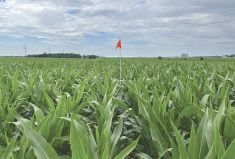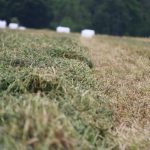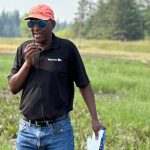Proponents of big yields often make the same observation. Whether it’s in corn with American record holders Francis Childs or Herman Warsaw, or it’s in soybeans, with Dr. Gary Ablett at Ridgetown Campus once pegging our potential soybean yield at 250 bu./ac., the talk always turns to “attention to detail.”
Yet what confounds Eric Richter is that so many growers pay more attention to their corn crops than they do their soybeans. It’s also why changing the management mindset on soybeans has become a focal point in his recent work with growers.
Read Also

Agronomists share tips for evaluating new crop products and tech: Pt. 3
With new products, new production practices and new technology converging on the agriculture industry at a frenetic pace in recent…
Richter is a sales agronomist with Syngenta, and Country Guide has written previously about his approach. For this Soybean Guide, we talked to him to explore five more parameters that continue to confound many growers.
Overall, Richter contends there is a lack of intensity when it comes to growing soybeans. Not necessarily intensity in terms of higher levels of inputs, but in terms of the intensity of management skill applied to soybean production, including scouting and awareness of what’s happening in the crop.
Indeed, Richter is convinced soybeans are actually the more challenging crop to grow. Yet he also feels many growers are skeptical that anything they do will reliably boost their yields.
“Growers might ask why they’re pouring good money after bad, and that’s unfortunate,” says Richter, who’s brought much of what he learned working in forages into the soybean sector. “The ‘good money after bad’ scenario becomes a self-fulfilling prophecy.”
Where some insist that corn yields have outpaced soybeans, Richter states that research data from tests under a high-management system where genetic potential is assessed indicates soybean yields are increasing at roughly the same percentage rate as corn.
Yet those same practices aren’t always employed at the farm level. Theoretical yield for corn is 500+ bu./ac., with an on-farm provincial average of 170 bu./ac., meaning the crop actually achieves more than 30 per cent of its theoretical yield.
In soybeans, if the theoretical maximum is 250+ bu./ac., actual yields of 45 to 48 bushels are less than 20 per cent.
High, medium and low
Something else that isn’t well understood is how to shift management to a high-, medium- and low-zone approach. Even though a precision agriculture system can help a grower manage a field in increments of feet or inches, Richter maintains it’s easier to keep things simple. That means recognizing that each field will have areas that are high-producing potential, medium potential and low, mainly due to soil factors such as organic matter levels, water-holding capacity, cation exchange capacity (CEC), and other parameters that will determine inherent productivity potential.
Within that overview Richter addresses four key components of improving soybean yields through intensive management: weed management, canopy closure, disease management and uniformity of stand. Each can have different subheadings and influences, but make no mistake: each has taken on greater importance in this “just enough” era in managing soybeans.
Have soybeans become the crop that’s regarded as being able to take care of itself? It’s capable of fixing its own nitrogen and has a reputation for yield consistency (hardiness). (For example, how soybeans can suffer a 40 per cent loss of a stand and still reach a 90 per cent of yield index.)
But Richter says, “that this belief is part of the problem.
“I say it over and over again: the ability of a soybean plant to tolerate stress and still deliver a harvestable crop is amazing,” he says. “With soybeans at 45 bu./ac., it pays the bills but there’s not much left over. Is that where we want our growers to be, or growing the best crop possible? Well, 45 isn’t anywhere close to that.”
In order to push production levels, growers need to shift their focus from bushels per acre to impact on yield as a percentage. Richter cites a five per cent response, and positions it within that high-, medium/middle- and low-zone approach, where highs are 75 to 80 bu./ac., mid-yield zones are 55 to 60 and the lows are about 40 bu./ac.
This means a five per cent increase is 4.0 bu./ac. in the high zone, 3.0 bu./ac. in the middle and 2.0 bu./ac. in the low management zone. From the low to high zone is a 100 per cent difference, and in Richter’s book, that yield increase is extra money in a grower’s pocket.
Weed management — the easy target?
When Dr. Clarence Swanton introduced the concept of the critical weed-free period in corn in the early 2000s, the effect was incredible. Seed companies lauded the research and growers slowly began to follow Swanton’s lead, at least where spring planting and weed management strategies were concerned. When Swanton updated his work in 2014, it provided further insight into the way weeds can affect corn, even while the seed is still below surface.
At the same time, there’s been less of a focus on the critical weed-free period in soybeans, even though the soybean plant’s shorter stature is liable to be affected to a greater extent during the vegetative period. It can be argued that if a corn seedling is affected by an emerged weed seedling of the same height, it’s likely a similar situation for a soybean seedling.

To Richter, the manner in which weeds interact with corn or soybeans during the grain-fill period is radically different. In most cases, he says, advisers recommend and growers try to control weeds in corn during that critical weed-free period, so the corn plant experiences its massive growth spurt and it will often canopy over any late-season weeds so they won’t significantly affect yield.
“I would say that’s not true with soybeans,” adds Richter. “If we have those weeds that break through the canopy and tower above our soybean crop during the bean-fill period, they’re impacting yield in a very negative way.”
In fact, Richter and his colleagues with Syngenta have been recommending to many growers that to manage weeds in their corn crops, they should consider a two-pass system, where they’re doing an application as a pre-plant incorporated (PPI) followed by an in-crop post application. In soybeans, more growers who are using herbicide-tolerant varieties are also using a herbicide with residual activity with their burn-down. He believes that to be a positive step in terms of managing more of the weed species in the field.
In this way, weed management relates closely to canopy closure, an event during the growing season which Richter insists must occur early in order to maximize yield and full genetic potential of the soybean crop. In 2016, many growers made a switch in row width — from 15 inch to 30 inch. The move was expected to help reduce the severity of white mould, which has become an issue for more farmers in southern Ontario in the past two or three years, and is now a perennial headache in eastern Ontario. What growers didn’t count on was the early-season drought across much of the province. In many cases, that shift to 30-inch rows cost them, not only in yield, but in terms of weed management, where failure to close the canopy led to weed escapes and the potential for those added flushes to set seed and contribute to the soil weed-seed bank for subsequent years. Although it’s impossible to predict drought, the decision to widen rows will likely have an impact on weed management well into 2017.
This is also where canopy closure is often underestimated: it encompasses at least three different parameters — and likely more — in its breakdown. Row width (and the favoured “W” pattern across a field), plant type (thin or bushy), and seeding rate are all closely related to canopy closure and its impact on yield. Richter cites 15-inch rows as the most popular choice across much of Eastern Canada. A small percentage of provincial area is planted on heavier clay and lower organic matter sands, necessitating 7.5-inch widths. The balance of the soybean acreage — spread across the province, including eastern Ontario — employs 30-inch row widths. In many cases, this row-width strategy is twofold: first to maximize planting equipment efficiency and also perhaps as a means of mitigating the effects of white mould.
“For years we have said as an industry that as long as you have ‘X’ thousand plants per acre, you won’t have to do a replant, and that number’s been approximately 100,000,” says Richter, adding that he’s been part of that chorus. “What I’ve learned recently is that statement has misled many growers. On those heavy clays and low-organic sands — where they are typically planting with 7.5s and 15s, if they’re counting and getting an average of 100,000 plants and not replanting, they take a huge yield hit because the crop will not close canopy quickly enough, if at all. The biggest challenge for those growers is to close canopy and build a large enough plant factory.”
A unique way to assess canopy development is the “W” canopy. At 7.5 inches, it’s unlikely a grower can see that “W” at field level. The crop tends to be too thick and there isn’t that trough-like character to the profile, which often leads to lodging, particularly if the crop is seeded too heavily.
In 15-inch rows, as well as 18s, 20s and 30s, the “W” should be apparent, and Richter states that’s a good thing to see. For the majority of soybean growers, medium-row width — 15s to 20s — will optimize yield. It will close canopy and with the right population, will maximize yield. With 30s, he says, it takes a very special situation with healthy soils in a high production zone to make that row width work.
“We often say that soybean is the first crop to truly show that you have a major soil health problem,” says Richter. “Your yield flatlines and you just can’t seem to move yields forward, even if you put more fertilizer on. These are key indicators that growers are suffering with poor soil health.”
Another factor within canopy closure is plant type. Here the concern is the different plant types for soybeans, from slender or thin-line plants to full-bush, wide-row beans. There are also height classes but it’s usually more of the branching characteristics that are cited in canopy closure.
“If we’re trying to control white mould with 30-inch rows and keeping population to about 150,000, and yet plant without knowing that we’re planting a variety that’s more to the slender side, the odds are we won’t canopy,” says Richter. “And yes the odds are we probably won’t have much white mould, and your yield will be okay. But the slender plant type in a 30-inch row won’t maximize yields.”
Finally, on canopy closure, the adage “seeding rate trumps row width” is another important factor, particularly for growers planting in narrow to medium row widths. In comparing 7.5s to 30s, seeding rate may not entirely trump row width, but within 7.5, 15, 18 and 20 inch, the impact that population can have — from the W-shaped canopy, optimizing the leaf area and finding “the sweet spot” — seeding rate is really the one that does it.
There is a part of the discussion that surrounds planting date, and in most cases, that does have an impact, where the earlier it’s planted, generally, the more orderly emergence can take place, then canopy closure and moving in a positive direction towards the reproductive stages. If you plant early with 30-inch rows and use a slender plant type, it likely won’t matter, because canopy closure is going to be a big challenge with that plant type.
“Look at what we’ve learned from the double-cropping practice, where canopy closure at R1 is not possible in medium to wide row configurations,” says Richter. “Even 15s won’t see a canopy closure at R1, so in a double-cropping year, 7.5s must be the row width.”
Better pest control
In spite of all that’s known about pests and diseases, it is shocking to contemplate the impact of soybean cyst nematode (SCN). In fall 2015, Syngenta started a Clariva PN promotional travelling road show to get growers to bring soil samples, do a quick test to determine the presence of SCN, and if it was present, to send that sample on to A&L Canada Laboratories for confirmation of SCN races.
There are two primary sources of resistance in the fight against SCN: PI 88788 and PI 548402 (the “Peking” gene). PI 88788 is the primary source of resistance in roughly 95 per cent of soybean varieties in North America. The Peking source accounts for most of the remaining five per cent with a third source — PI 437654 (Hartwick or CystX as they’re known) unavailable in any commercial varieties currently in use.
That near-total reliance on a single source of resistance is creating potential increased susceptibility when the same variety is planted back to back to back in the same field, or in tighter rotations with just corn and soybeans.
“As a result, with poor genetic rotation and overall tight cropping rotations, we’re encouraging the cyst to adapt and select for the races that are not currently controlled with the genetics in use,” says Richter, also pointing out that it’s difficult to shift resistance sources. “The challenge that we have is that SCN resistance sources have a strong correlation between gene sources and yield. When SCN-resistant varieties were first introduced in the 1990s, those varieties had a yield lag.”
There are still fields in Ontario that have no detectable levels of SCN and the onus is on those growers to keep things that way. At the same time, there are now fields across much of western Ontario with high rates, some of which have only been detected in the past two years. Yet these fields have shown signs of having been host to the pest for up to 10 years.
That’s the issue with SCN: many farmers deny they have it, in spite of symptoms and the available tools to deal with the pest, including different varieties and new seed treatments. And that’s why Richter believes his company’s SCN road show is such a positive move — it takes the identification process right up to the farmer’s front door.
Uniformity of stand
Last on the list is uniformity of stand, which is closely linked to the “picket-fence” stand, a common term in corn production. In soybeans, it’s still important and is a favourite topic of Richter’s.
In cornfields, agronomists, advisers and dealers have used the picket-fence image to highlight the uniformity-of-stand concept. In particular, there are three important aspects: diameter (of the stalk), the spacing between stalks, and ear placement and size. The diameter provides an indication of emergence, intra-row spacing is an indication of uniform seed spacing and the ear placement and size provide some idea of uniformity of plant growth. It’s best if the ears are all located along the same plane within the row. The best cornfields have a uniform appearance.
In soybeans, there hasn’t been that same emphasis on uniformity of emergence or spacing. Again, if a grower is happy with 45 bu./ac. yield, picket-fence stand (or its counterpart in soybeans) likely won’t matter. The industry standard response has been, “As long as you have at least 100,000 or it’s roughly uniform, don’t worry about it.”
Yet Richter is focused on picket fencing in soybeans. While it’s true soybeans have a tremendous compensatory power, he says, if soybeans aren’t emerging at the same time, you get into that “runt of the litter” syndrome, and that leads to lost yield.
What’s truly surprising is that other industries have adopted the uniformity-of-stand principle as an important factor in performance and production. Richter points out that the horticulture sector and forest industry have acknowledged the value of uniform emergence and stands. Syngenta has documented this effect using what’s known as micro counts measuring in one-foot increments. For example, in spite of an average of 150,000 plants per acre, final population in some growers’ soybean fields, it’s been determined that in some places within those fields, the populations can vary from 220,000 in some parts to less than 150,000 in others.
“Where do we see this? With growers who use drills or planters with bean cups, or those with the wrong plate,” says Richter. “These are where the uniformity of stand and the uniformity of spacing can be compromised in soybeans.”
This article originally appeared in the October 2016 issue of the Soybean Guide
















